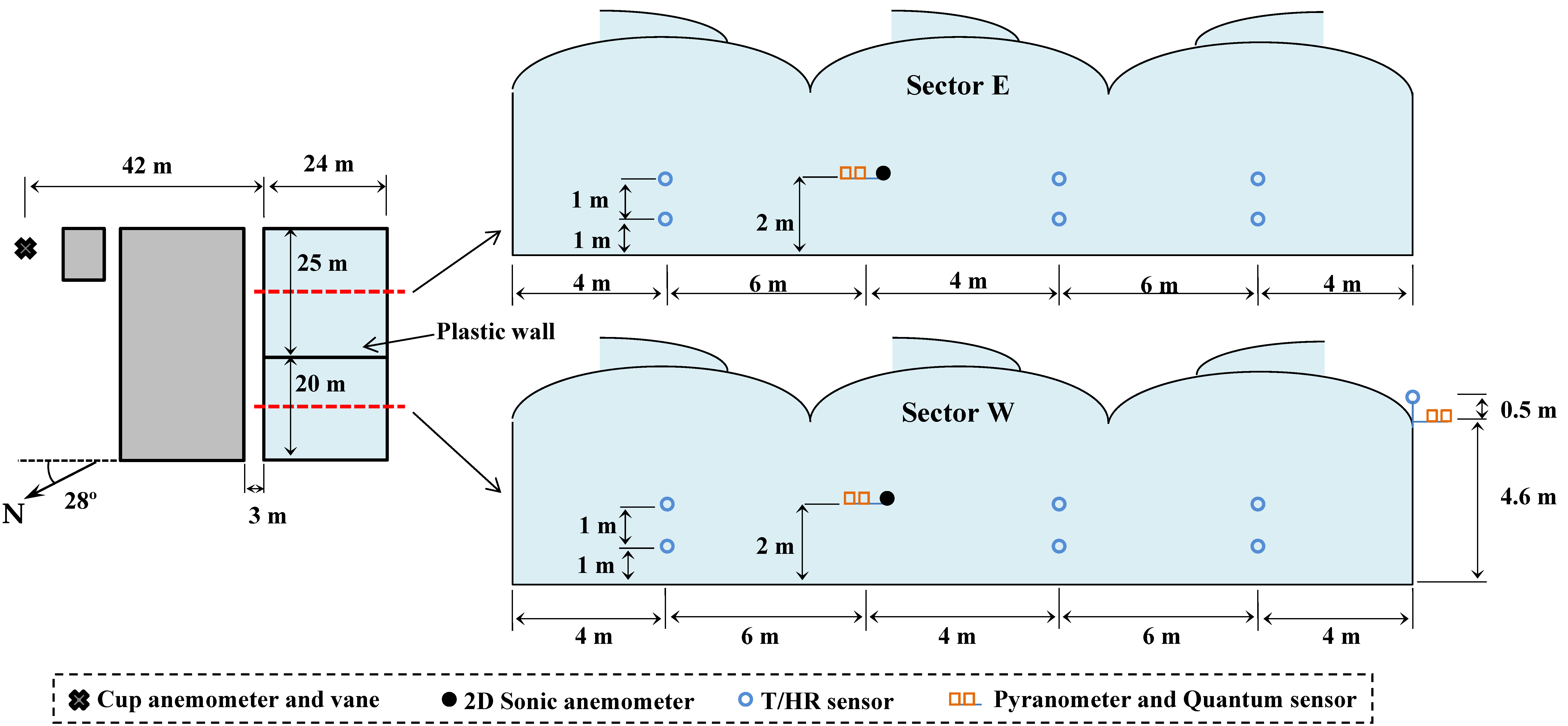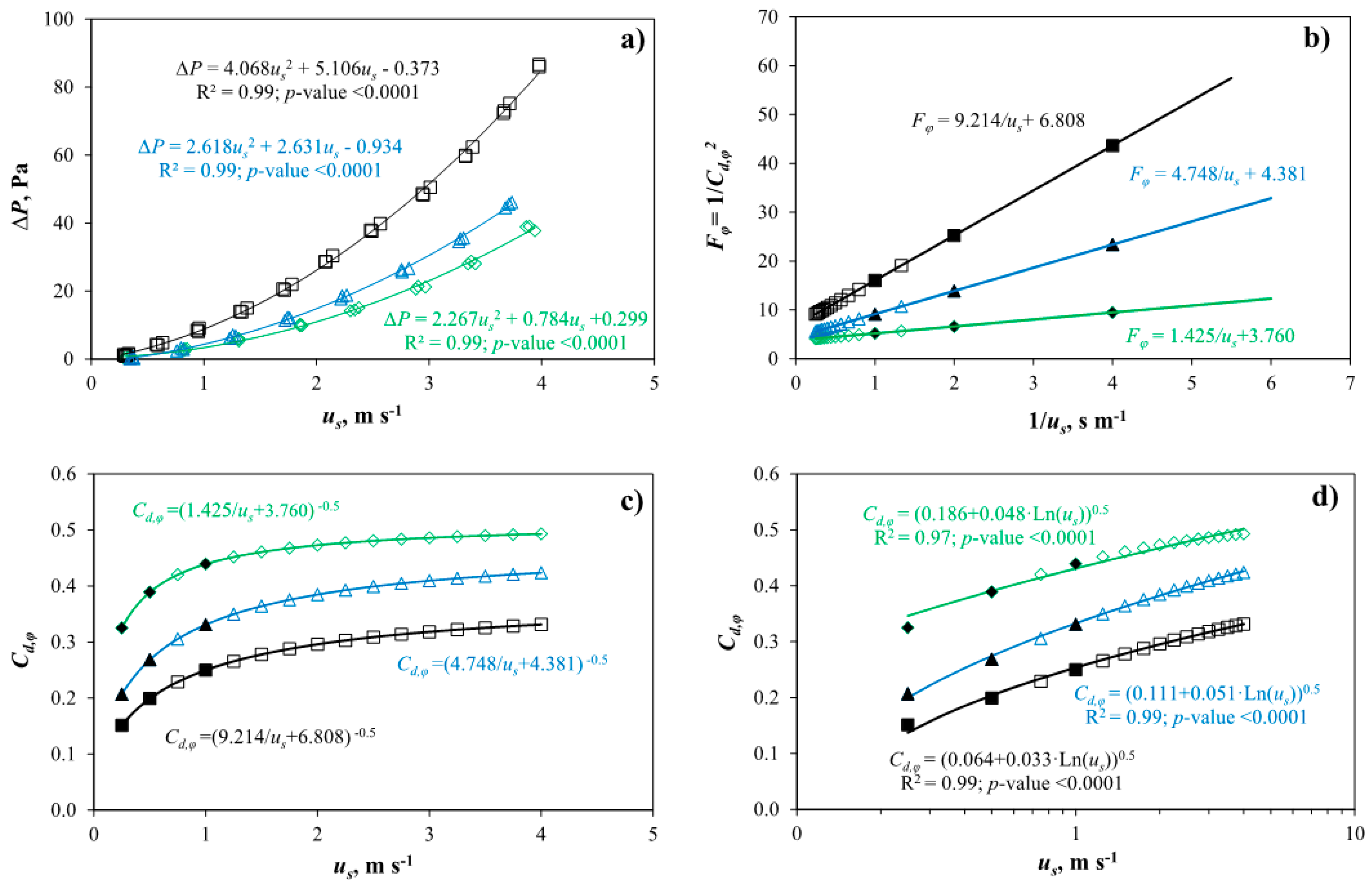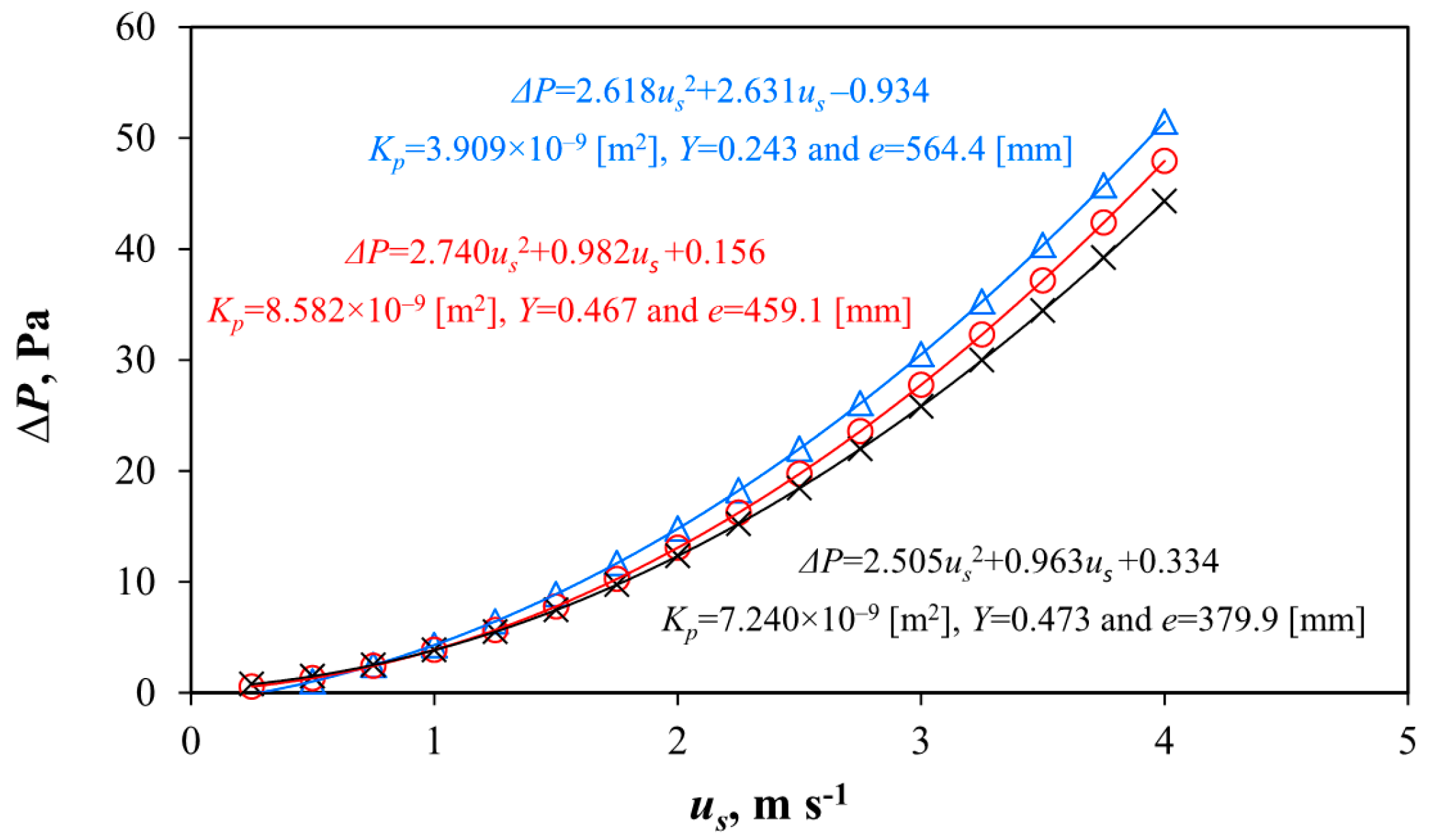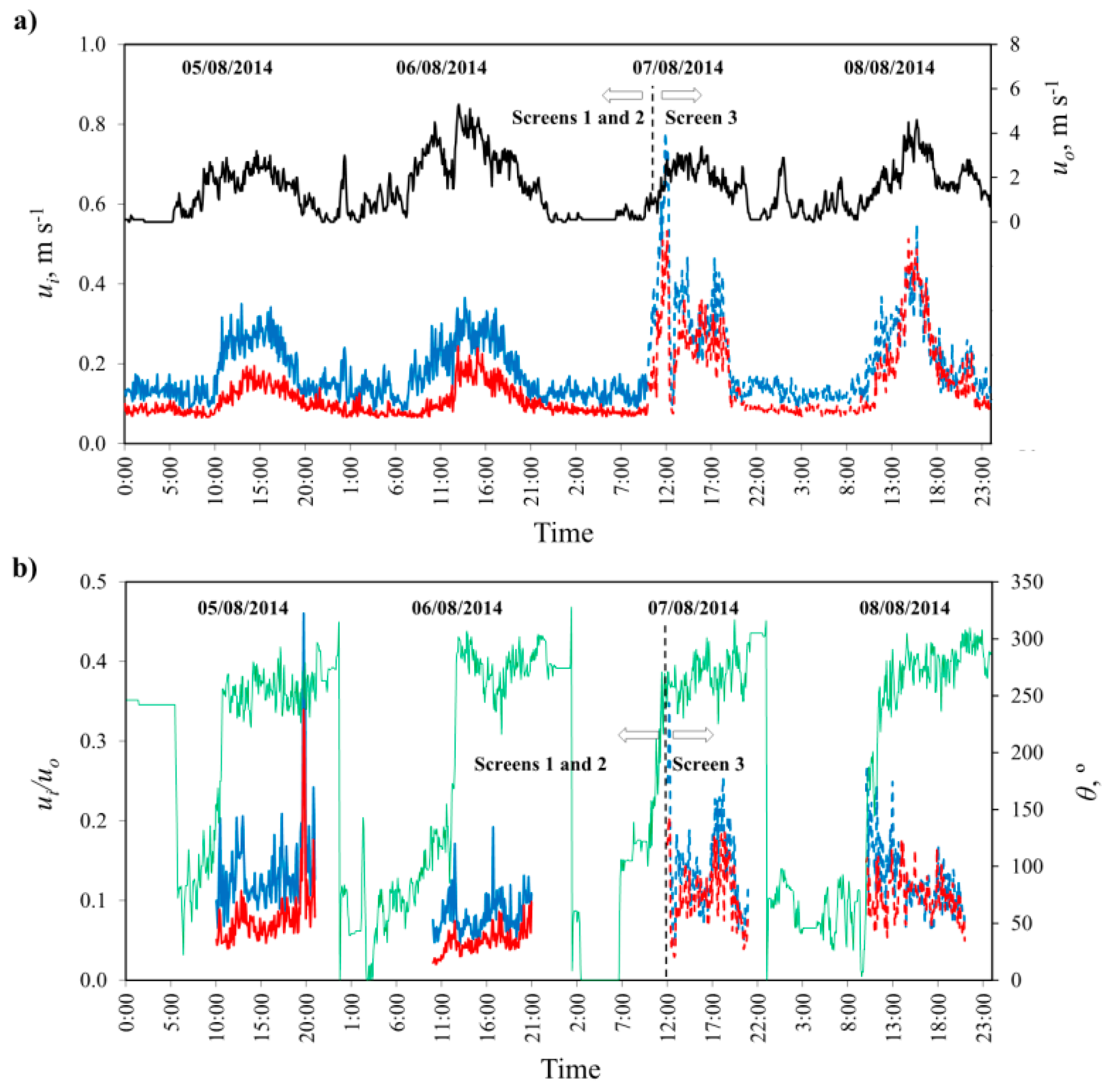The first results presented concern the geometric characterisation of the insect-proof screens, highlighting the difference in porosity between screens 1 and 2. The second set of results was obtained in the low-velocity wind tunnel. That data obtained allow us to estimate the reduction in the greenhouse air renovation rate produced by the placement of the screens in the vent openings. It is expected that the reduction in the screen porosity will diminish the air renovation rate. The final section of the results analyses the microclimatic data obtained on the days of the experiments in the greenhouses.
3.1. Geometric Characteristics of the Insect-Proof Screens
The geometric analysis of the three insect-proof screens shows that number 3, installed in both sectors
E and
W for the second set of tests carried out in the experimental greenhouse, had the same thread density as screen 1 (10 × 20 threads·cm
−2), but slightly higher porosity (
Table 2). The main difference between screens 1 and 3 is the pore length
Lpy. On the other hand, although screen 2 is less porous, its smaller pore size (weft pore length
Lpx, warp pore length
Lpy, diameter of the circumference drawn inside the pore
Di and pore surface
Sp) constitutes an advantage as it will be more effective in preventing the access of harmful insects to the crop [
12].
When choosing an insect-proof screen, therefore, growers must weigh two factors: (i) greater porosity will benefit the natural ventilation of the greenhouse, particularly in warmer climates; (ii) smaller pore size will benefit the insect-proof screen’s efficacy in preventing the entrance of pests in the greenhouse. Bethke and Paine [
43] observed that insect-proof screens with pore size (
Lpx) lower than twice the width of the insect’s thorax were effective in not allowing whitefly to pass through. Based on the geometric analysis (
Table 2), screen 2 (
Lpx = 110.0 ± 7.9 µm) is expected to be more efficient than screen 1 (
Lpx = 238.6 ± 19.5 µm) and screen 3 (
Lpx = 239.9 ± 18.5 µm) as a barrier against the whitefly
Bemisia tabaci, with a mean thorax width of 215.8 µm and 261.8 µm for the male and female, respectively [
43]. Álvarez [
9] analysed the efficiency of several screens in preventing the entrance of
Bemisia tabaci, concluding that insect-proof screens with mean
Lpx values of between 187.3 μm and 250.3 μm were practically 100% effective. As a barrier against thrips (
Frankliniela occidentalis), which has a mean thorax width of 184.4 µm and 245.5 µm for the male and female, respectively [
43], screens 1 (
Lpx = 238.6 ± 19.5 µm) and 3 (
Lpx = 239.9 ± 18.5 µm) would not be effective, whereas screen 2 (
Lpx = 110.0 ± 7.9 µm) would. However, one characteristic of this insect is that it can fold its wings, and it has been seen to be able to pass through screens with mean
Lpx values of 118.5 µm [
9]
3.2. Aerodynamic Characteristics of the Insect-Proof Screens
Table 3 presents the results obtained in the wind tunnel experiments at low velocities (0–4 m·s
−1) for the three insect-proof screens (
Figure 3a). Screen 2, with higher thread density (13 × 30 threads·cm
−2) and lower porosity (26.3%) than the other two screens, gave rise to the highest pressure drop. Screen 1 with the same thread density (10 × 20 threads·cm
−2) but with slightly lower porosity and greater thickness than screen 3 (
Table 2) produces a greater pressure drop. Therefore, two insect-proof screens of the same thread density can have a different aerodynamic behaviour resulting from several minor geometric differences.
The parameter
Kp appears to increase with the screen porosity, which was also observed by Miguel
et al. [
42] and Teitel [
16]. The latter work found that the inertial factor
Y increased along with the porosity of the insect-proof screen, whereas the former work did not. In the present work, comparison of insect-proof screens 1 and 3 (35.0% and 36.0% porosity, respectively) showed that the inertial factor was greater for screen 3, which was less thick than screen 1.
On the other hand, screen 2, of less porosity and thickness than the other two, presented an intermediate recorded inertial factor. Therefore, the inertial factor seems to be related to the porosity and the thickness of the insect-proof screens. The aerodynamic characteristics of the insect-proof screens (
Kp e
Y) allow us to determine the discharge coefficient due to the insect-proof screen
Cd,φ (
Figure 3c).
The coefficient
Cd,φ can be calculated from the pressure drop coefficient
Fφ previously determined in the wind tunnel experiments (
Figure 3b) [
4,
15]:
In order to obtain a numerical value for
Fφ, we must calculate the Reynolds number based on the permeability of the insect-proof screen Re
p. Applied to porous media, this Reynolds number can be calculated as [
44]:
where
us is the air velocity through the insect-proof screen,
ρ is the air density (kg·m
−3) and
μ the air viscosity (kg·s
−1·m
−1) calculated for the daytime mean air temperature of 35 °C recorded in the experimental greenhouse. The physical relation between
Cd,φ and the velocity can be obtained from Equations (1)–(3):
In our case we have carried out this theoretical fit between the value of
Cd,φ and the air velocity through the screen
us (
Figure 3c). This type of curve allows us to characterise the aerodynamic behaviour of each insect-proof screen, and it would be convenient if manufacturers were to provide this information. Others authors observed that the coefficient
Cd,φ was a function of the logarithm of the Reynolds number [
16], which in turn depends on the air speed through the insect-proof screen
us. Thus, we can approach the theoretical function of
Cd,φ (
Figure 3c) with a logarithmic relationship (
Figure 3d), with a good correlation coefficient but based on a statistical fitting.
We can characterise the aerodynamic behaviour of an insect-proof screen for a specific temperature of air during the test (influencing its density
ρ and viscosity
μ) with only two parameters, the coefficient
a and
b of the polynomial relationship between pressure drop and air velocity (
Figure 3a). The ratio
a/
b defines the behaviour of screens at air velocities lower and greater than 1 m·s
−1. For velocities lower than 1 m·s
−1, the coefficient b is more important to compare two screens. However, for velocities greater than 1 m·s
−1 the coefficient a become significate when analysing the pressure drop produced by the screens. To define the screens as a porous medium (with independence of the temperature during the test) we can use three parameters: the permeability
Kp, the inertial factor
Y and the thickness
e. These three parameters are used in CFD simulations of screens as porous media [
3]. We can observe how there are screens with different values of
Kp and
Y, but with different thickness resulting in similar different pressure drops (
Figure 4).
In order to estimate the effect of the different insect-proof screens on the ventilation capacity of the experimental greenhouse, and therefore on the inside temperature, we have determined the total discharge coefficient
Cd for the roof vent of the experimental greenhouse. This coefficient can be calculated using the following expression [
12,
33,
45]:
The coefficient
Cd,LH depends on the geometry of the vent (equivalent to the coefficient
Cd of a vent without insect-proof screen) and can be obtained as follows [
46]:
where
LV is the length of the vent (m),
h the height of the vent (m) and
α the angle of opening, which is 14° for the roof vent. For the roof vents in the experimental greenhouse
Cd,LH was 0.718 in sector
E and 0.711 in sector
W.
The discharge coefficient
Cd was calculated with insect-proof screen 1 on the roof vent in sector
E, and with screens 2 and 3 on the roof vent in sector
W (
Table 4). It was determined for a reference air velocity us of 0.25, 0.5 and 1.0 m·s
−1. The value of 0.25 m·s
−1 for air velocity is the maximum mean value of the longitudinal component
ux, perpendicular to the vents, observed in a similar experimental greenhouse [
4].
The discharge coefficient values due to the presence of the insect-proof screen
Cd,φ presented in
Table 4 were similar to those obtained in previous works following the same methodology [
4,
15]. The values of
Cd are similar to those obtained by other authors and compiled by Molina-Aiz
et al. [
15], in the range of 0.16 to 0.51 for vents with insect-proof screens whose porosity varied between 25% and 45%. For instance, in an Almería-type greenhouse fitted with an insect-proof screen of 34% porosity, a
Cd value of 0.194 was obtained [
15]. When comparing
Cd values obtained by different authors, one should also bear in mind the fact that this coefficient depends on the Reynolds number Re
p [
15], which in turn depends on the air velocity through the porous medium.
The discharge coefficients obtained at the roof vents in each sector of the greenhouse allow us to estimate the reduction that one insect-proof screen will cause with respect to another one, based on the ratio
Cd,screen2/
Cd,screen1 [
4,
34]. Previous research works have used this ratio to compare greenhouses with and without insect-proof screens; for instance, Katsoulas
et al. [
21] and Kittas
et al. [
14] obtained a ratio of 0.67 for an insect-proof screen of 50% porosity and Kittas
et al. [
33] obtained a value of between 0.44 and 0.46 for an insect-proof screen of 60% porosity. In the present work the ratio
Cd,s2/
Cd,s1 was 0.74 (
us = 0.25 m·s
−1), which indicates that in theory the less porous medium (screen 2) should bring about a 26% reduction in the natural ventilation capacity in sector
W (with screen 2) of the greenhouse in comparison with sector
E (with screen 1). Surprisingly, between the two commercial screens of similar thread density and porosity there is a similar difference in the discharge coefficient (
Cd,s1/
Cd,s3 = 0.67) to the one between the two commercial screens of different thread density (
Cd,s2/
Cd,s1 = 0.74). Wang
et al. [
47] also observed as two screens with the same bi-dimensional porosity and characteristic (length and width pore and filament width) produced different pressure drops, and therefore, different discharge coefficients, as consequence of its different tri-dimensional geometry.
After analysing screens 1, 2 and 3, we can suppose that the geometric characteristics of screen 2 make it more efficient as a barrier against insects, but we can state that its aerodynamic characteristics results in a greater reduction of the natural ventilation capacity of the greenhouse than those of screens 1 and 3.
3.3. Air Velocity Inside the Greenhouse
Between 12:00–16:00 on the 5th and 6th of August, the mean air velocity
ui values on the horizontal plane XY were 0.16 m·s
−1 in sector
W (screen 2) and 0.27 m·s
−1 in sector
E (screen 1); which implies a 40.7% reduction in inside air velocity. On the 7th and 8th of August, with the same screen fitted in both sectors, the values of
ui recorded were 0.28 m·s
−1 in sector
W and 0.34 m·s
−1 in sector
E; which implies a difference of 17.6%, which may be due to the difference in ventilation surface or the location of the anemometers. Kittas
et al. [
14] observed a 58% fall in the air velocity value inside a tunnel-type greenhouse (with only side vents) fitted with 50% porosity screens, in comparison to the greenhouse without screens.
In
Figure 5 we can observe how the difference in air velocity at the centre of the two greenhouse sectors
ui is more uniform at night, when the wind speed is low and the ventilation airflow is less notable, observing very similar differences for the four nights analysed (around 0.05 m·s
−1). However, the difference between air velocity measured at the centre of the two sectors that constituted the greenhouse, increases at midday on the first days (5 and 6) when the screens installed in the two sectors were different, but decreases at midday on the last two days (7 and 8) when the screens are the same in both sectors (screen 3).
The wind tunnel experiments allowed us to estimate using Equation (4) that the expected reduction in the air renewal rate in sector
W (screen 2) with respect to sector
E (screen 1) due to the difference in aerodynamic characteristics of the screens was 26% (
Cd,s2/
Cd,s1 = 0.74). In a previous work, López
et al. [
4] measured a 16% reduction in the greenhouse air renewal rate with a less porous screen (
φ = 33.5%) compared to a more porous one (
φ = 39.0%) in agreement with the theoretical reduction in the air renewal rate of 11% (
Cd,33.5%/
Cd,39.0% =0.89). These previous results confirm that the ratio
Cd,s2/
Cd,s1 provides an approximate value of the reduction in the renovation rate by natural ventilation produced by screen 2 respect to screen 1. The difference in aerodynamics characteristics of the three screens produces differences in the discharge coefficients of the vent openings, and consequently in the ventilation airflow, thus affecting the air velocity and temperature distribution inside the greenhouse. When a more permeable screen was used (
i.e., one with a greater discharge coefficient
Cd) we perceived higher air velocity at the centre of the greenhouse sector, indicating a greater ventilation airflow that cools the greenhouse air.
Although, the statistical relationship that best fits the experimental data is with an exponential function, we have use a linear relationship (
ui = 0.856
Cd + 0.062; R
2 = 0.68 and
p-value = 0.012) between the air velocity inside the greenhouse
ui and the discharge coefficient of the windows
Cd. This can be explained by the direct relationship between the volumetric airflow
G in the greenhouse and the discharge coefficient
Cd that multiply a function of inside-outside temperature difference in the greenhouse Δ
Tio and the wind speed
uo [
48]:
where
Go is the leakage airflow when openings are closed (m
3·s
−1).
The mean interior air velocity
ui can be considered to be proportional to the ventilation volumetric flux
G (Equation (7)) divided by the vertical cross-section surface perpendicular to the average direction of the inside airflow
SCS [
49]:
We can deduce a linear relationship between the inside air velocity and the discharge coefficient of the vent openings:
3.4. Air Temperature Inside the Greenhouse
The first air temperature analysis compared the mean daily and daytime values and the mean values for the hottest part of day (12:00–16:00) in the two sectors of the greenhouse (
Table 5). Using an insect-proof screen of 26.3% (screen 2) as opposed to 35.0% (screen 1) porosity gave rise to a mean daily temperature increase of 2.3 °C, while the increase in mean daytime temperature was 3.7 °C, and the increase during the hottest part of the day was 4.8 °C. The maximum temperatures recorded were 44.6 °C and 48.4 °C in sectors
E and
W, respectively, and the maximum difference between the two sectors at any given moment was 7.7 °C at the afternoon (
Figure 6).
With insect-proof screen 3 in both greenhouse sectors (7th and 8th of August), no significant differences in temperature were observed (
Figure 6), with mean values at midday of 34.9 °C and 34.8 °C in sectors
E and
W, respectively (
Table 5). This indicates that the differences recorded on the 5th and 6th of August were primarily due to the different characteristics of screens 1 and 2. The mean temperatures recorded with insect-proof screen 3 fitted in both sectors of the greenhouse (7th and 8th of August), were lower than those recorded with screens 1 and 2 on the 5th and 6th of August (
Table 5 and
Figure 6), though outside temperatures were quite similar (
Figure 6a). This ratifies that the better aerodynamic characteristics of screen 3 (higher
Cd) have improved the greenhouse ventilation capacity in comparison to screens 1 and 2, increasing the greenhouse’s cooling capacity and allow lower temperatures inside.
There is a proportional relationship between the thermal gradient values
∆Tio and the discharge coefficient
Cd [Δ
Tio = (−141.82 + 52.87/
Cd)
0.5] and as consequence and the mean air velocity at the centre of the greenhouse
ui [Δ
Tio = (−135.85 + 57.88/
ui)
0.5]. The difference in temperature between inside and outside is reduced by increasing
Cd and the air velocity. Teitel [
16] also observed an increase of temperature and humidity inside the greenhouse when the pressure drop
Fφ increased, and therefore the discharge coefficient
Cd decreased. As mentioned in the introduction section, we have chosen to analyse the effect of insect-proof screen in the microclimate of empty greenhouses to avoid the cooling effect that plants transpiration produce in cropped greenhouses.
No differences were observed between the levels of inside absolute humidity
xi between sectors, nor between inside
xi and outside
xo the greenhouse, Δ
xio ≤ 0.0006 (kg·kg
−1) (
Table 5). This similarity in air humidity inside both greenhouse sectors, provide a guarantee that the main parameter that affects the inside greenhouse microclimate is the ventilation airflow affected by the type of insect-proof screens installed in the vent openings.













